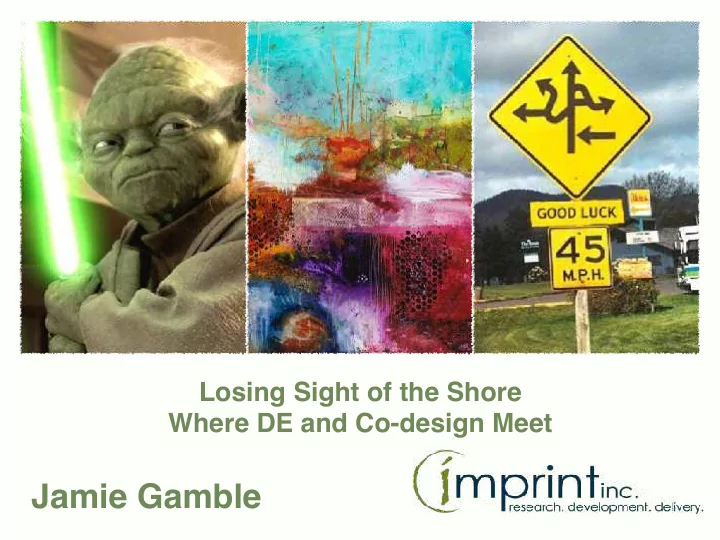

Losing Sight of the Shore Where DE and Co-design Meet Jamie Gamble
Wicked Systems Problems • Are unique and have no precedent • Do not have definitive criteria or indications for the right solutions • Are difficult to address and change with every attempt to address it • Involve many stakeholders with different values and priorities Adapted from Strategy as a Wicked Problem. John C. Camillus. Harvard Business Review, May 2008.
Complexity • Causes and drivers that are interdependent and filled with uncertainties • Cause + Effect are coherent only in retrospect and do not repeat
Innovation + Complexity • New ways of understanding problems • Space for exploration and experimentation • Search for scale strategies
Evaluation • Cause + Effect = repeatable, perceivable and predictable • Monitor implementation for high fidelity, assurance and quality. • Pre-ordinate specificity, clarity of outcome • Test and validate stable change model
Evaluation + Innovation + Complexity • Learning by doing • Rapid feedback cycles • Frame the issue, and track evolving understanding • Guide strategy decisions and forks in the road • Develop principles
One doesn’t discover new lands without first consenting to lose sight of the shore, for a very long time. ANDRÉ GIDE THE COUNTERFEITERS, 1925
NouLab
The Activity of the Lab The Design of the Lab The Case for the Lab
The Activity of the Lab The Design of the Lab The Case for the Lab
Small bets before big bets Probes Prototypes Pilot Scaling •Politics •Competing priorities Explore concepts Build versions of •The state of knowledge about a and ideas, ideas, rapid Testing and Policy, understand the feedback, learn by validation, dissemination, problem nature of the doing, variation implementation replication •The availability of resources system and iteration Adapted from Mark Cabaj, Here to There
Power and Resource Culture Routines Relationships Authority Flows Shared Organizational Policy changes Accounting learning norms Decision Budget system Alignment of Adoption of maker commitments Training purpose language commitments practices Collaborations What is half way to systems change?
The Activity of the Lab The Design of the Lab The Case for the Lab
Would you tell me, please, which way I ought to go from here? That depends a good deal on where you want to get to. LEWIS CARROLL ALICE IN WONDERLAND, 1864
IF we do…. A B C D E THEN it will result in…. X Y Z WHICH will ACHIEVE… Our intended impact
Challenge our assumptions and Prototype validate our alternatives hypothesis by C 1 Adapt B of C Replace with F adapting as we F B learn… C 2 Do more of D IF we do…. A C 3 B E D D GROUNDED in these theories …. J K L THEN it will result in…. X Y Z W Our revised WHICH will ACHIEVE… Our intended intended impact impact
Design of the Lab • What helps / what hinders people in moving through the lab • Pedagogy and approach to learning • Sequence of content and experiences • Who is involved and the implications of that • Quality and nature of the innovations in development • How prototyping, testing and procurement play out in the different situations • Partnership dynamic and nature of the relationship in the innovation teams • Level of executive buy in and how this affects what is in development
Design of the Lab • Optimum kind of problem to be addressed • The purpose of the Lab: Sandbox? Solve problems? Shift systems? • Lab’s role in thought leadership • When and how do good ideas in development get handed off? • Alternatives to a Lab process?
The Activity of the Lab The Design of the Lab The Case for the Lab
What are the essential values for how we do labs? What is the accountability ceiling of a lab?
Let me stand next to your fire. JIMI HENDRIX ARE YOU EXPERIENCED, 1970
Thank You
Recommend
More recommend